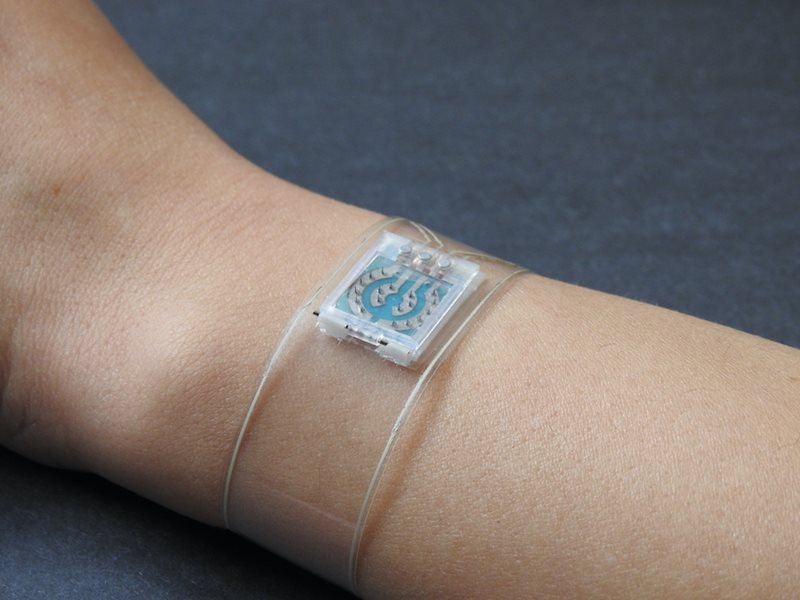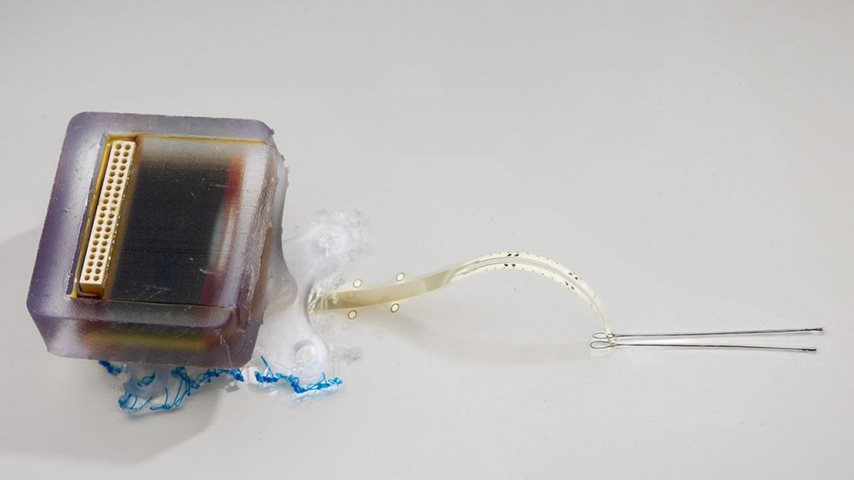Wristband Optimizes Diabetes and Heart Health Monitoring in One Device
Wristband Optimizes Diabetes and Heart Health Monitoring in One Device


A flexible wristband uses a microneedle array to track glucose, lactate, and alcohol levels in real time, providing for earlier diabetes detection and better management.
At the University of California San Diego, engineers are reimagining diabetes monitoring through a wearable wristband that painlessly tracks glucose and cardiovascular health using a replaceable microneedle array.
The flexible wristband features a microneedle array which gently draws interstitial fluid from beneath the skin to monitor glucose, lactate, and alcohol levels in real time. Each microneedle contains specialized enzymes that enable precise measurement. For convenience and safety, the array is designed to be easily replaced, allowing users to adjust wear times while reducing the risk of allergic reactions or infection and supporting extended wear.
At the same time, the wristband employs an ultrasonic sensor array to track blood pressure and arterial stiffness, while ECG sensors capture heart rate directly from the wrist. These physiological signals are critical markers of cardiovascular risk—commonly elevated in people with diabetes, which are monitored continuously outside clinical environments.
Since 2021, postdoctoral researcher An-Yi Chang from UC San Diego’s Aiiso Yufeng Li Family Department of Chemical and Nano Engineering has been developing the wristband with the goal of providing a more complete view of health. Chang explained that glucose is only part of the picture—factors like diet, exercise, alcohol, and stress also affect blood sugar and heart health, yet are often overlooked by traditional monitors.
Relevant Reads: Digitizing Hydration: Tattoo-Like Sensor Could Save Lives
“My work has focused on designing and optimizing wearable devices that enable minimally invasive glucose, lactate, alcohol, and vital signs monitoring,” Chang said. “Through this research, we developed pain-free, accurate and cost-effective devices that can improve the daily lives of people with diabetes and support monitoring for early signs.”
The need for such interventions is evident since diabetes grows as a global health problem. More than 589 million adults are currently living with diabetes—about one in nine adults, which is constantly increasing. In 1990, about 7 percent of adults had diabetes. By 2022, the number had doubled to 14 percent, according to the World Health Organization (WHO).
“Diabetes affects millions of people worldwide, including members of my own family, providing me with personal motivation to address this critical health challenge,” Chang said.
The WHO estimates that about 50 percent of people with diabetes don’t know they have it, especially common in Type 2 diabetes which does not present with noticeable symptoms in the early stages.
“The wristband is developed to monitor the risk of developing diabetes, ideally prior to the onset of pre-diabetes or diabetes,” Chang said.
Describing the wristband, Chang explained the most innovative aspect is the fabrication of the microneedle.
“It is constructed on a 100-um-thick flexible tape, allowing it to conform to the curved surface of the wrist,” he said. “The microneedle is made with SU-8, a biocompatible material, and is designed to penetrate the skin with a tip diameter of less than 10 um and length greater than 800 μm. The SU-8 microneedle offers high accuracy for real-time monitoring.”
The second breakthrough lies in in integrating three biomarkers with vital signs—a complex task that requires simultaneous, real-time monitoring of multiple signals.
“It took considerable time to address these challenges,” Chang said. “To minimize cross-talk effects, we had to carefully adjust the spacing between the sensors and optimize the wiring design.”
“This is the first time a wearable BLUE wristband has been introduced to monitor chemical biomarkers of glucose, lactate, alcohol, and physical vital signs of blood pressure, heart rate and arterial stiffness in real time,” he continued.
The wristband’s development involved fabricating microneedles in a cleanroom, determining the optimal number per biomarker—six for each— and conducting cross-talk studies between the microneedle, ECG, and ultrasound sensors to ensure accurate, interference-free data collection.
The team also designed the wristband’s structure and wiring layout for stable connections, then performed on-body testing during different activities to assess performance and reliability in real-world conditions.
Discover the Benefits of ASME Membership
Trials included participants across varied scenarios—fasting and non-fasting, drinkers and non-drinkers, athletes and non-athletes, and individuals at high risk for diabetes but without symptoms.
To ensure that the readings were accurate, they were compared to readings from various commercial devices at the same time including a glucose meter, lactate meter, a breathalyzer, and a blood pressure monitor.
The wristband itself is made from Styrene-ethylene-styrene (SEBS), which Chang noted is very flexible.
Looking ahead, Chang said a patent is pending for the device and the SU-8 microneedle will advance to the clinical trials on patients with different symptom profiles.
With user consent, the wristband’s data could be shared with physicians to help monitor health trends and make more informed insulin and treatment decisions.
“The device continually records important data throughout their daily activities, providing positive feedback that can motivate users to adopt healthier lifestyle changes,” Chang said.
Annemarie Mannion is a technology writer in Chicago.
The flexible wristband features a microneedle array which gently draws interstitial fluid from beneath the skin to monitor glucose, lactate, and alcohol levels in real time. Each microneedle contains specialized enzymes that enable precise measurement. For convenience and safety, the array is designed to be easily replaced, allowing users to adjust wear times while reducing the risk of allergic reactions or infection and supporting extended wear.
At the same time, the wristband employs an ultrasonic sensor array to track blood pressure and arterial stiffness, while ECG sensors capture heart rate directly from the wrist. These physiological signals are critical markers of cardiovascular risk—commonly elevated in people with diabetes, which are monitored continuously outside clinical environments.
Since 2021, postdoctoral researcher An-Yi Chang from UC San Diego’s Aiiso Yufeng Li Family Department of Chemical and Nano Engineering has been developing the wristband with the goal of providing a more complete view of health. Chang explained that glucose is only part of the picture—factors like diet, exercise, alcohol, and stress also affect blood sugar and heart health, yet are often overlooked by traditional monitors.
Relevant Reads: Digitizing Hydration: Tattoo-Like Sensor Could Save Lives
“My work has focused on designing and optimizing wearable devices that enable minimally invasive glucose, lactate, alcohol, and vital signs monitoring,” Chang said. “Through this research, we developed pain-free, accurate and cost-effective devices that can improve the daily lives of people with diabetes and support monitoring for early signs.”
From global health crisis to personal motivation
The need for such interventions is evident since diabetes grows as a global health problem. More than 589 million adults are currently living with diabetes—about one in nine adults, which is constantly increasing. In 1990, about 7 percent of adults had diabetes. By 2022, the number had doubled to 14 percent, according to the World Health Organization (WHO).
“Diabetes affects millions of people worldwide, including members of my own family, providing me with personal motivation to address this critical health challenge,” Chang said.
The WHO estimates that about 50 percent of people with diabetes don’t know they have it, especially common in Type 2 diabetes which does not present with noticeable symptoms in the early stages.
“The wristband is developed to monitor the risk of developing diabetes, ideally prior to the onset of pre-diabetes or diabetes,” Chang said.
Describing the wristband, Chang explained the most innovative aspect is the fabrication of the microneedle.
“It is constructed on a 100-um-thick flexible tape, allowing it to conform to the curved surface of the wrist,” he said. “The microneedle is made with SU-8, a biocompatible material, and is designed to penetrate the skin with a tip diameter of less than 10 um and length greater than 800 μm. The SU-8 microneedle offers high accuracy for real-time monitoring.”
The second breakthrough lies in in integrating three biomarkers with vital signs—a complex task that requires simultaneous, real-time monitoring of multiple signals.
“It took considerable time to address these challenges,” Chang said. “To minimize cross-talk effects, we had to carefully adjust the spacing between the sensors and optimize the wiring design.”
“This is the first time a wearable BLUE wristband has been introduced to monitor chemical biomarkers of glucose, lactate, alcohol, and physical vital signs of blood pressure, heart rate and arterial stiffness in real time,” he continued.
Engineering a multi-sensor system for real-time insights
The wristband’s development involved fabricating microneedles in a cleanroom, determining the optimal number per biomarker—six for each— and conducting cross-talk studies between the microneedle, ECG, and ultrasound sensors to ensure accurate, interference-free data collection.
The team also designed the wristband’s structure and wiring layout for stable connections, then performed on-body testing during different activities to assess performance and reliability in real-world conditions.
Discover the Benefits of ASME Membership
Trials included participants across varied scenarios—fasting and non-fasting, drinkers and non-drinkers, athletes and non-athletes, and individuals at high risk for diabetes but without symptoms.
To ensure that the readings were accurate, they were compared to readings from various commercial devices at the same time including a glucose meter, lactate meter, a breathalyzer, and a blood pressure monitor.
The wristband itself is made from Styrene-ethylene-styrene (SEBS), which Chang noted is very flexible.
Looking ahead, Chang said a patent is pending for the device and the SU-8 microneedle will advance to the clinical trials on patients with different symptom profiles.
With user consent, the wristband’s data could be shared with physicians to help monitor health trends and make more informed insulin and treatment decisions.
“The device continually records important data throughout their daily activities, providing positive feedback that can motivate users to adopt healthier lifestyle changes,” Chang said.
Annemarie Mannion is a technology writer in Chicago.







